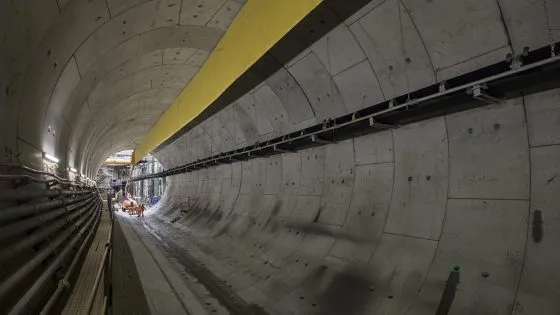It’s been five years in the making, throwing up multiple technical challenges. But the long-awaited Silvertown Tunnel in east London finally opened this week.
The £2.2bn project to construct a 1.4km twin-lane road tunnel under the River Thames to connect North Greenwich and Silvertown has been no mean feat.
It was the first tunnel to be built under the capital’s main tributary in more than 30 years, and the project involved building under existing infrastructure and knocking through a historic filled-in dock – not to mention overcoming difficulties surrounding the mighty River Thames.
But as the first cars filed through, there were only smiles, pride and relief for the team behind its construction.
“I think I need a holiday now,” project director Borja Trashorras chuckled.
For the past five years he has overcome the knock-on effects of Covid and the war in Ukraine on the sector to steer the Riverlinx Construction Joint Venture (CJV) between Bam Nuttall, Ferrovial Construction and SK Ecoplant.
Trashorras has worked for Ferrovial for the past 15 years.
As he looked down on the tunnel from the control room, he smiled as he told Construction News of some of the trials and tribulations the project created prior to its opening on Monday (7 April).
“The first major challenge was managing the stakeholders and getting 1,700 consents and permissions off the stakeholders in the area,” he said.
“We then had to make sure we did not impact the operations of asset owners surrounding us by meticulous planning, monitoring, and stakeholder engagement throughout the different stages of the project.
“But the biggest task was rotating the tunnel boring machine (TBM) in the Greenwich peninsula – which was a UK first.”
The team used an 82-metre long TMB, nicknamed Jill, which weighed 1,800 tonnes and was the largest ever used in the UK.
Due to space constraints at the Greenwich end of the tunnel, the team developed a nitrogen skate system to turn it around.
“The second big challenge was the excavation of the ground conditions,” Trashorras said.
“The water level in this area is high and the ground is not very stable so we had to use various measures such as ground freezing.
“Despite all the challenges, we managed to deliver the programme on time. We had hyperinflation caused by the Ukraine war and labour and materials shortages due to Brexit to deal with and in that context for this project it was massive pressure for us. But we did it.”
Construction on site began in March 2021 and in 2023 the tunnel drives were completed throughout the year. The past two years saw mechanical and electrical work taking place, followed by testing and commissioning prior to the tunnel’s opening.
Space constraints
Standing in the tunnel and pointing up, Riverlinx tunnel manager Ivor Thomas told CN that Damien Hirst’s iconic 2023 statue Demon with Bowl was above our heads as he spoke of the challenges faced working in the heart of the city.
“We were in post-industrial London, smack bang in central London, working around existing infrastructure, including the cable car foundations, the DLR viaduct and the river walls, and we started at the beginning of Covid. It was tough,” he said.
“One of the challenges was an old dock that fed the Queen Victoria Dock from the river, which had been backfilled in the 1940s. It took quite a lot of knocking out.”
Riverlinx environmental manager Ruth Garcia echoed his thoughts.
She explained that 50,000m3 of excavated material from the tunnel was either saved to be reused later in the process or loaded on to barges and removed by river.
Some of it was used for backfilling the tunnel itself, specifically the sections at either end, which were built using a cut-and-cover method.
“As we were in central London, it was really challenging due to the lack of space,” she said. “Due to the geographical surroundings, it was a complex urban environment to work in.”
A full 600,000 tonnes of spoil was taken to the Ingrebourne Valley nature park, where it is being used to restore local areas into sustainable sites.
The tunnel, which was funded through a PFI scheme, is expected to take 25,000 vehicles a year and generate more than £100m a year through tolls.
Transport for London (TfL) said it will repay the cost of the tunnel over 25 years and any amounts left over will be reinvested in transport in London.
For Stuart Harvey, TfL’s chief capital officer, the tunnel will be a gamechanger for the city and will help ease the nightmare of the Blackwall Tunnel’s constant closures for beleaguered motorists.
“This is going to be a key benefit for London,” he said.

